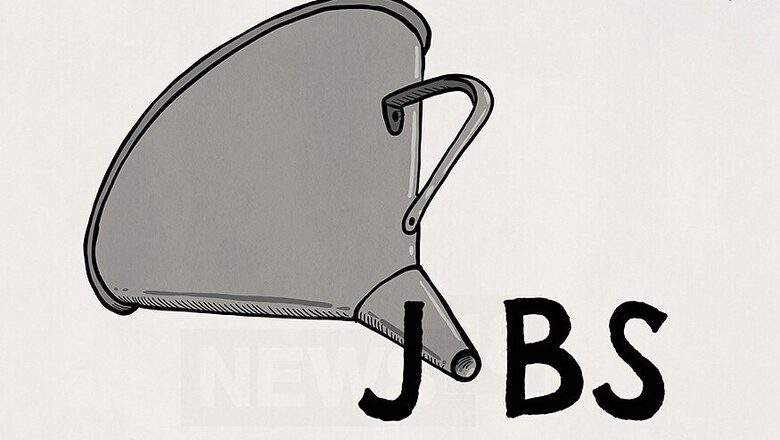
views
A slowing economy has often thrown up questions on the unemployment rate among Indian youth. Our GDP is expected to have hit a multi-quarter low at below five per cent for the July-September quarter this fiscal (official data for which is yet to be released), prompting fresh concerns over job creation. Economists have been arguing that India’s shrinking industrial output, slower growth in services and a slowing external trade amid slackening investments by corporate India may have all contributed to rising joblessness. But government data has not proved this theory in any conclusive manner, though private agencies have shown that unemployment is on the rise.
Previous government labour data, with which current numbers could have been compared, have been rendered incomparable with present stats since the methodology for the periodic labour force survey (PLFS) was changed some time back. So, when a leaked PLFS report showed that India’s unemployment rate for people aged 15 years and above was at a 45-year high of six per cent in 2017-18, the government said these numbers were not comparable with previous data since the survey methodology had been changed.
Against this background comes the latest quarterly PLFS report for January-March 2019 (Q1 2019) showing a slight improvement in unemployment parameters over the immediate previous quarter (Q4 2018). According to the PLFS for 2019, the unemployment rate in urban areas for all ages was 9.3 per cent in Q1 2019, down from 9.9 per cent in Q4 2018 and lowest in a year. For people aged 15 years and above, this figure was 9.2 per cent, down from 9.7 per cent in Q4 2018. And for the youth, 15-29 years, unemployment rate was 22.5 per cent, compared to 23.7 per cent in Q4 2018. So the unemployment rate has fallen sequentially for all the three categories of workers the PLFS tracks.
But private data sources have been talking of a rise, not a dip, in unemployment. Data from the Centre for Monitoring Indian Economy (CMIE), showed that the unemployment rate was 6.87 per cent between January and April this year, a significant increase from 5.5 per cent in the same four months of 2018 and a slight increase from the unemployment rate of 6.67 per cent in the September-December period of 2018. The sample size, methodology, etc, are different for CMIE and PLFS.
Anyway, the pertinent data point to note from the latest PLFS is that at least every fifth Indian youth remains jobless with unemployment staying above 22 per cent for a year. Is this not a worrying state of affairs despite marginal improvement in jobs data?
Another point to ponder: the PLFS data also shows that the labour force participation rate (LFPR) has dipped in Q1, indicating that a weak economy may be forcing people to quit looking for jobs and withdraw from the workforce. The LFPR for all ages in urban India was 36 per cent in Q1 2019 against 36.3 per cent in Q4 2018. If one were to take just the urban youth, in the 15-29 year age group, the LFPR dipped to 37.7 per cent from 38.2 per cent quarter on quarter, showing the rate at which urban youth – the most employable segment of any population – has been withdrawing from the labour force.
Then, while national official statistics provide some cheer in terms of unemployment percentage, a look at the conditions in different states throws up a mixed bag. Take Kerala for example. India’s most literate state (as per the 2011 Census) continues to house the highest proportion of unemployed urban youth among all states while Gujarat has the least percentage of jobless youth.
The PLFS 2019 data shows that 37.2 per cent urban youth were unemployed in Kerala in Q1 2019 this year. In other words, at least every third urban youth in the state was jobless when the national percentage of unemployment was 22.5 per cent or at least every fifth. For Gujarat, the unemployment among urban youth stood at just 9.5 per cent, or less than even one in 10.
https://english.mathrubhumi.com/news/kerala/36-25-lakh-are-unemployed-in-kerala-outnumbers-national-average--1.4241096
This piece in the Mathrubhumi newspaper says that over 36 lakh people, including medical and engineering graduates, remain unemployed in the state. And among the unemployed youth, women outnumber men, with over 23 lakh women remaining unemployed.
The PLFS shows that more than six in 10 (60.1 per cent) urban young women in Kerala were jobless in Q1 2019 against 29 per cent at the national level and this was an increase from 57.6 per cent such women in the immediately preceding quarter. The percentage of unemployed young women hovered around the 60 per cent mark of only two other states this year: Uttarakhand and Jammu & Kashmir. Gujarat continued to provide employment to the maximum number of young urban women with the unemployment rate in this category lowest among all states, at 10.5 per cent, even though this was the highest unemployment among urban young Gujarati women in a year.
The PLFS data also leads us to another worrying trend: declining female labour force participation and rising female unemployment. The female LFPR remains between 16-17 per cent, which means only every sixth woman is even seeking employment. For Q1 2019, the LFPR for women was 15 per cent (all ages) against 56.2 per cent for men. For the age group of 15-29 years, it was 16 per cent, versus 57.9 per cent for men. Nearly three in 10 young women were unemployed in Q1 on an all-India basis but, in some states, the ratio of women employed was highly skewed.
(Author is a senior journalist. Views are personal)




















Comments
0 comment